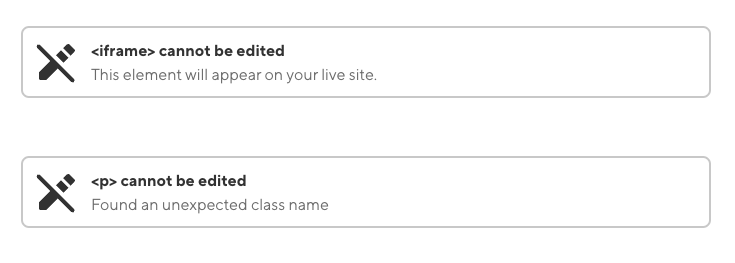You can edit markup content in one of CloudCannon's three rich text editors: the Content Editor, editable regions in the Visual Editor, or Rich Text inputs. However, CloudCannon will handle some markup content differently.
CloudCannon uses the following definitions:
- Rich text content — any HTML, Markdown, or MDX content you might want to edit in the Content Editor, an editable region in the Visual Editor, or a Rich Text input.
- Custom markup — any HTML, Markdown, or MDX structure that cannot be recreated in a rich text editor (e.g.,
<div>tags or style attributes). This is usually any structure that the WYSIWYG toolbar cannot produce.
Editing custom markup in a rich text editor comes with risk. This is because:
- You can unintentionally delete custom markup from your files. CloudCannon cannot render custom markup in the rich text editor; therefore, it would be easy to backspace or accidentally delete your HTML structures. Because the WYSIWYG toolbar cannot produce custom markup, it cannot be recreated if you accidentally delete it.
- Some custom markup structures pose a security risk to your Site by enabling cross-site scripting attacks (e.g.,
<script>tags) and other unwanted interactions between your code and the editing interface (e.g.,<style>tags).
To get the most out of your editing experience, we recommend that you only include markup that can be rendered and edited in a CloudCannon rich text editor.
Unsupported HTML elements in rich text editors#
To protect your content and your site, CloudCannon does not allow you to edit custom markup using the Content Editor or a Rich Text input by default. Although you cannot edit your custom markup in the Content Editor or rich text inputs, CloudCannon will preserve it. Your custom markup will appear as an uneditable Snippet.

By default, you can edit some custom markup using editable regions, but not any custom markup that poses a risk for cross-site scripting attacks.
You can still edit the surrounding content in your files using a rich text editor and edit your custom markup in the Source Editor.
Best practice for custom markup#
To ensure your files remain editable in the rich text editor, we recommend the following solutions to avoid some common pitfalls:
- Remove custom markup from inside elements with
class='editable'. Any other markup inside your editable region may cause the region to become an uneditable Snippet. - Create a Snippet. Depending on your SSG, there are libraries of Snippets available, or you can create custom Snippets.
- Use postprocessing to add the desired HTML during the build (e.g., using Hugo's Markdown render hooks).
Configure how CloudCannon handles custom markup#
You can configure how CloudCannon handles custom markup using the allow_custom_markup and remove_custom_markup keys.
The allow_custom_markup key enables you to edit custom markup in rich text editors and explicitly accept the risk of unintentionally deleting elements that cannot be recreated. By default, allow_custom_markup is false for inputs and the Content Editor and true for editable regions.
The remove_custom_markup key enables you to strip custom markup from content edited in a rich text editor, allowing you to clean files of unnecessary HTML content. By default, remove_custom_markup is false for inputs, the Content Editor, and editable regions.
For more information, please read our rich text editor reference.